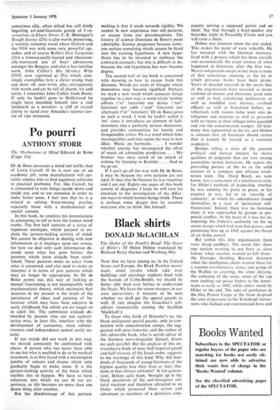Po pourri
ANTHONY STORR
The Mechanism of Mind Edward de Bono (Cape 35s) Dr de Bono possesses a mind not unlike that of Lewis Carroll. If he is ever out of an academic job, some manufacturer will cer- tainly employ him to find ingenious solutions to practical problems. For, like Carroll, he is concerned to turn things upside down and inside out, and to use nonsense in order to make better sense. I feel sure that he is a wizard at solving brain-teasing puzzles, especially those with a mathematical or spatial content.
In this book, he employs his inventiveness in attempting to tell us how the human mind works. The first half consists of a series of ingenious analogies, which purport to ex- plain the pattern-making activity of mind. We cannot be objective in dealing with new information as it impinges upon our senses, for how we deal with such information de- pends upon what has gone before: the patterns which have already been estab- lished. These patterns make us select from what is presented, and also tend to make us interpret it in terms of past patterns which may no longer be appropriate. As Dr de Bono points out, this way of looking at mental functioning is not incompatible with psychoanalytic theory, which maintains that neurosis in the present is the result of the persistence of ideas and patterns of be- haviour which may have been adaptive in early childhood, but which are no longer so in adult life. The submissive attitude de- manded by parents who are too authori- tarian may, in later life, interfere with the development of autonomy, since submis- siveness and independence cannot easily co- exist.
If our minds did not work in this way, we should constantly be confronted with chaos. A person who has never been able to see but who is enabled to do so by medical treatment, is at first faced with a meaningless jumble of colours and shapes which only gradually begin to make sense. It is the pattern-making activity of the brain which enables this to happen. We have to have schemata into which we can fit our ex- perience, or life becomes no more than one damn thing after another.
But the disadvantage of this pattern- making is that it tends towards rigidity. We cannot fit new experience into old patterns, or escape from our preconceptions. The history of science illustrates de Bono's point admirably. Science progresses because some- one notices something which cannot be fitted into the existing hypothesis. A new hypo- thesis has to be invented to embrace the awkward anomaly; but this is difficult to do, because the old hypothesis has now become dogma.
The second half of the book is concerned with showing us how to escape from this dilemma. Words are tools of thought which themselves may become rigidified. Perhaps we need a new word which connects things together in a new way; a word which 'neither affirms ("is" function) nor denies ("not" function) nor adds ("and" function) nor alternates ("or" function).' Dr de Bono gives us such a word. I wish he hadn't called it 'PO', since it introduces an element of ludi- crousness into a perfectly serious discussion, and provides ammunition for hostile and irresponsible critics. Po is a word which links incompatibles and thus opens the way to new ideas. Music po hormone. . . . I wonder whether anyone has investigated the effect of music on adrenaline production. . . . My brother was once cured of an attack of asthma by listening to Kreisler. . . . And so we go on.
If I can't go all the way with Dr de Bono, it may be because my own patterns are too rigid. It may also be because he is a visualiser and I am not. Eighty-one pages of this book consist of diagrams. I hope he will turn his attention to the investigation of the differ- ent ways in which human beings think. There is perhaps some danger that he assumes everyone else to think like himself.














































 Previous page
Previous page